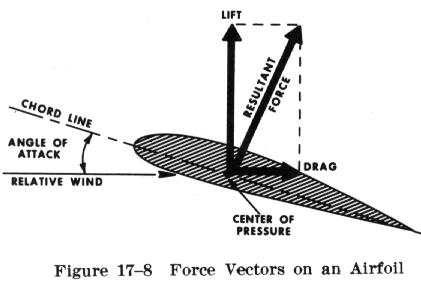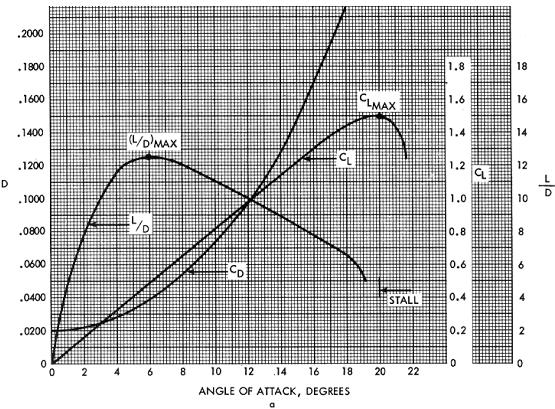
Air through which the wing moves creates a force the components
of which are referred to as "lift" and "drag" (Fig. 17-8). The resultant
force, or "force vector," is resolved trigonometrically into these components
of lift and drag, perpendicular and parallel, respectively, to the direction
of the undisturbed "relative wind." The lift is the upward force
which sustains the airplane in flight. The drag which retards the airplane's
forward motion determines the thrust necessary to propel the wing through
the air. It is evident, therefore, that the airplane designer is interested
in obtaining an airfoil that will produce high lift and low drag over the
airplane's flying range of "angles of attack," (the angle of attack being
the acute angle between the chord of an airfoil and the direction of the
relative wind). The airplane designer's choice of an airfoil is influenced
primarily by structural considerations, and chttp://aus.liveatc.net:80/kjax2
onsequently it may not be possible
to use an airfoil section that offers the greatest aerodynamic efficiency.
| +From aerodynamic theory and from wind tunnel tests using smoke so that the actual airflow can be seen, it has been found that the direction of the airstream, after passing over a wing, is changed slightly. The air, as it leaves the trailing edge of the wing, has imparted to it a downward velocity; and this mass of air, therefore, has downward momentum (downwash). As we have learned from Newton's third law of motion that "for every action there is an equal and opposite reaction," an upward reaction of lift is imparted to the wing. Further, the air passing over the top of an airfoil is accelerated. This results in reduction of pressure on top of the wing. Bernoulli's principle, "...as velocity increases, the pressure is reduced...," explains this additional factor in the development of a lifting force. |
 |
The drag of a wing is a rearward force which acts opposite to the direction of the airplane's forward motion and is made up of two components, the profile drag and the induced drag.
The profile drag is the resistance, or skin friction, due
to the viscosity (stickiness) of the air as it passes along the surface
of the wing, in combination with a form drag which is due to the eddying
and turbulent wake of air left behind. Profile drag may be thought of as
a pure resistance, such as is always encountered when an object is pulled
through a viscous medium.
Parasite drag, which applies to the entire airplane, is
composed of forces caused by protuberances extending into the airstream
which do not contribute to lift. Items such as radio antennas, struts,
fittings, landing gear, etc., produce parasite drag.
Induced drag is the direct result of the aerodynamic force resulting from the downward velocity imparted to the air as discussed previously. It may be said induced drag is the result of creating lift.
These forms of drag are more fully explained in later sections of this chapter. The lift and drag of a wing are forces that will vary with the density of the air, the area of the wing, the square of the air velocity, and the angle of attack of the wing as well as other parameters.

The manner in which the lift and drag will vary with the air density, wing area, and velocity factors is the same for any airfoil, but the variation of lift and drag with different angles of attack is a definite characteristic of each individual airfoil section. Graphs which show the variation of lift and drag with angle of attack are drawn for each airfoil design (Fig. 17-10).
The fact that these graphs give the lift and drag in terms of coefficients should not be confusing. Coefficients are numbers indicating the amount of some change under certain specified conditions, often expressed as a ratio. These coefficients include the mathematical calculations that make it possible to multiply the coefficient by the density, area, and velocity factors corresponding to any particular condition to determine the lift and drag forces in pounds.